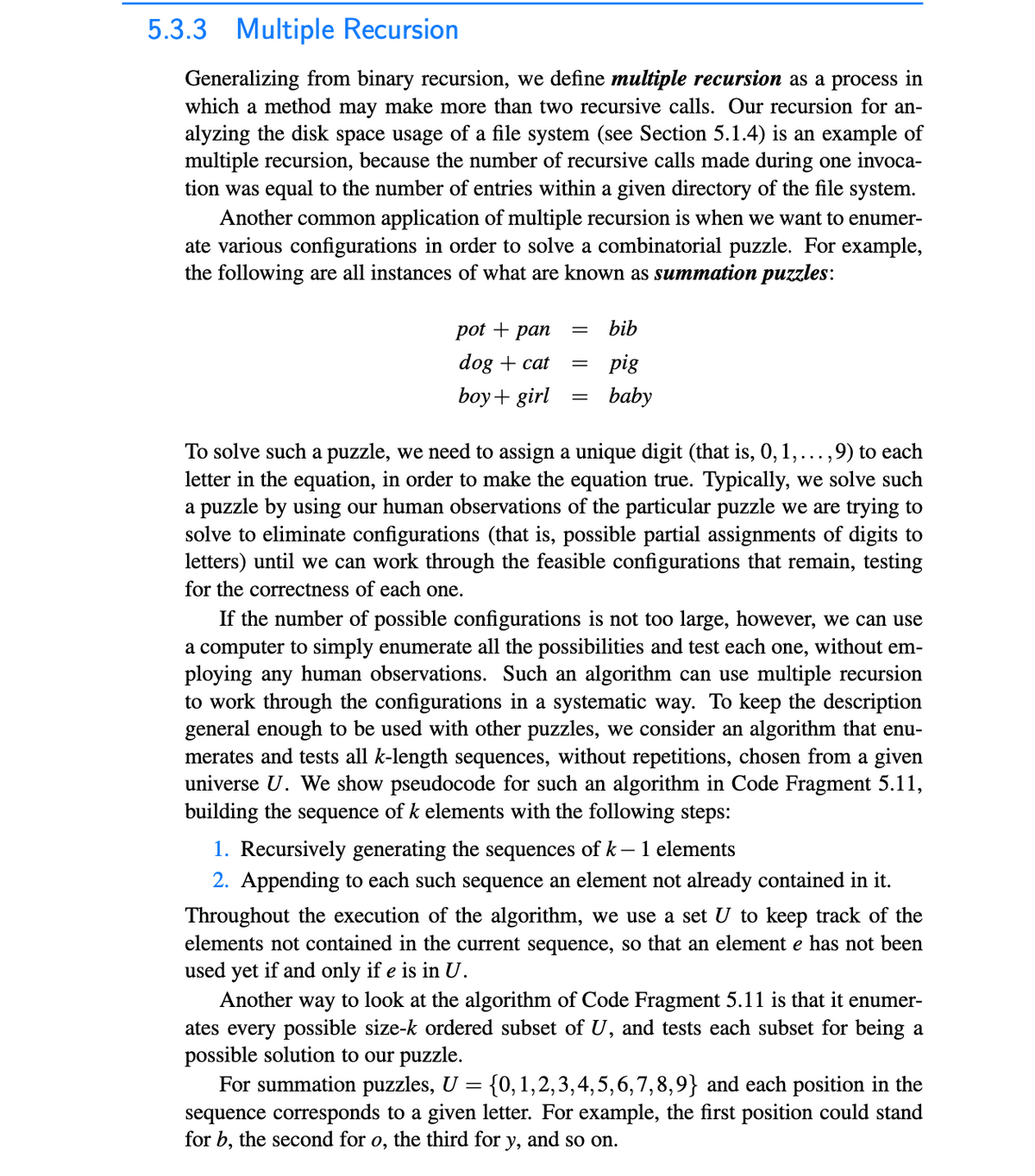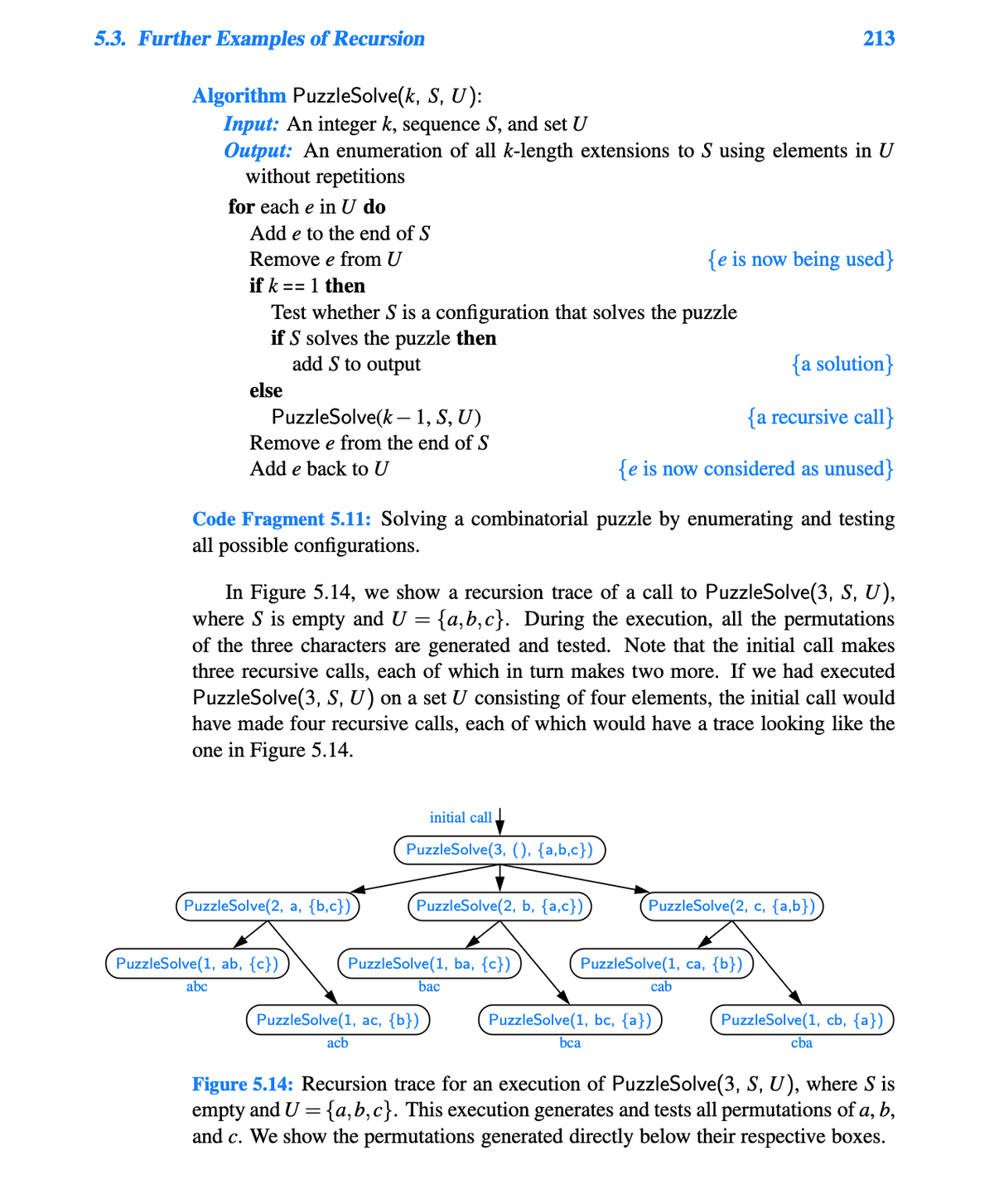Write a program for solving summation puzzles by enumerating and testing all possible configurations. Using your program, solve the three puzzles given in Section 5.3.3.
Write a program for solving summation puzzles by enumerating and testing all possible configurations. Using your program, solve the three puzzles given in Section 5.3.3.
C++ Programming: From Problem Analysis to Program Design
8th Edition
ISBN:9781337102087
Author:D. S. Malik
Publisher:D. S. Malik
Chapter17: Linked Lists
Section: Chapter Questions
Problem 2PE
Related questions
Question
Java
please help with the question below:
P 5.28: Write a program for solving summation puzzles by enumerating and testing all possible configurations. Using your program, solve the three puzzles given in Section 5.3.3.

Transcribed Image Text:5.3.3 Multiple Recursion
Generalizing from binary recursion, we define multiple recursion as a process in
which a method may make more than two recursive calls. Our recursion for an-
alyzing the disk space usage of a file system (see Section 5.1.4) is an example of
multiple recursion, because the number of recursive calls made during one invoca-
tion was equal to the number of entries within a given directory of the file system.
Another common application of multiple recursion is when we want to enumer-
ate various configurations in order to solve a combinatorial puzzle. For example,
the following are all instances of what are known as summation puzzles:
pot + pan = bib
dog + cat
boy + girl
=
=
pig
baby
To solve such a puzzle, we need to assign a unique digit (that is, 0, 1, ..., 9) to each
letter in the equation, in order to make the equation true. Typically, we solve such
a puzzle by using our human observations of the particular puzzle we are trying to
solve to eliminate configurations (that is, possible partial assignments of digits to
letters) until we can work through the feasible configurations that remain, testing
for the correctness of each one.
If the number of possible configurations is not too large, however, we can use
a computer to simply enumerate all the possibilities and test each one, without em-
ploying any human observations. Such an algorithm can use multiple recursion
to work through the configurations in a systematic way. To keep the description
general enough to be used with other puzzles, we consider an algorithm that enu-
merates and tests all k-length sequences, without repetitions, chosen from a given
universe U. We show pseudocode for such an algorithm in Code Fragment 5.11,
building the sequence of k elements with the following steps:
1. Recursively generating the sequences of k- 1 elements
2. Appending to each such sequence an element not already contained in it.
Throughout the execution of the algorithm, we use a set U to keep track of the
elements not contained in the current sequence, so that an element e has not been
used yet if and only if e is in U.
Another way to look at the algorithm of Code Fragment 5.11 is that it enumer-
ates every possible size-k ordered subset of U, and tests each subset for being a
possible solution to our puzzle.
For summation puzzles, U = {0, 1,2,3,4,5,6,7,8,9} and each position in the
sequence corresponds to a given letter. For example, the first position could stand
for b, the second for o, the third for y, and so on.

Transcribed Image Text:5.3. Further Examples of Recursion
Algorithm PuzzleSolve(k, S, U):
Input: An integer k, sequence S, and set U
Output: An enumeration of all k-length extensions to S using elements in U
without repetitions
for each e in U do
Add e to the end of S
Remove e from U
if k = 1 then
Test whether S is a configuration that solves the puzzle
if S solves the puzzle then
add S to output
abc
{a solution}
{a recursive call}
{e is now considered as unused}
Code Fragment 5.11: Solving a combinatorial puzzle by enumerating and testing
all possible configurations.
else
PuzzleSolve(k-1, S, U)
Remove e from the end of S
Add e back to U
PuzzleSolve(2, a, {b,c})
In Figure 5.14, we show a recursion trace of a call to PuzzleSolve(3, S, U),
where S is empty and U = {a,b,c}. During the execution, all the permutations
of the three characters are generated and tested. Note that the initial call makes
three recursive calls, each of which in turn makes two more. If we had executed
PuzzleSolve(3, S, U) on a set U consisting of four elements, the initial call would
have made four recursive calls, each of which would have a trace looking like the
one in Figure 5.14.
PuzzleSolve(1, ab, {c})
initial call
PuzzleSolve(3, (), {a,b,c})
(PuzzleSolve(2, b, {a,c})
PuzzleSolve(1, ba, {c})
acb
bac
PuzzleSolve(1, ac, {b})
{e is now being used}
PuzzleSolve(2, c, {a,b})
PuzzleSolve(1, ca, {b})
bca
213
cab
PuzzleSolve(1, bc, {a})
PuzzleSolve(1, cb, {a})
cba
Figure 5.14: Recursion trace for an execution of PuzzleSolve(3, S, U), where S is
empty and U = {a,b,c}. This execution generates and tests all permutations of a, b,
and c. We show the permutations generated directly below their respective boxes.
Expert Solution
This question has been solved!
Explore an expertly crafted, step-by-step solution for a thorough understanding of key concepts.
This is a popular solution!
Trending now
This is a popular solution!
Step by step
Solved in 4 steps

Knowledge Booster
Learn more about
Need a deep-dive on the concept behind this application? Look no further. Learn more about this topic, computer-science and related others by exploring similar questions and additional content below.Recommended textbooks for you

C++ Programming: From Problem Analysis to Program…
Computer Science
ISBN:
9781337102087
Author:
D. S. Malik
Publisher:
Cengage Learning

C++ Programming: From Problem Analysis to Program…
Computer Science
ISBN:
9781337102087
Author:
D. S. Malik
Publisher:
Cengage Learning